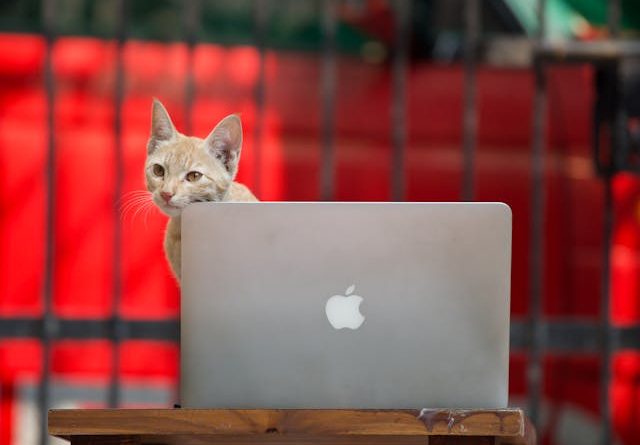Know How: Protecting Your PC from Pets
If you have pets, you know how much they love exploring, knocking things over, and sometimes even chewing on objects they shouldn’t. While their curiosity is endearing, it can also pose a real threat to your computer. From fur clogging the vents to accidental spills and chewed-up cables, pets can unintentionally cause serious damage to your PC. This can lead to expensive repairs or even complete system failure if the issue isn’t addressed in time.
Protecting your computer from your pets doesn’t mean you have to ban them from your workspace. With a few precautions and some smart planning, you can ensure that both your PC and your furry friend coexist peacefully. In this guide, we’ll go over more advanced strategies, moving beyond basic pet-proofing and into more sophisticated approaches that will keep your technology safe without restricting your pet’s natural behavior.
Understanding the risks pets pose to computers
At a surface level, most people think of pet-related computer issues as minor inconveniences – fur getting into the keyboard, a cat walking across a laptop, or a dog pulling a cable loose. However, the reality is that prolonged exposure to pet-related hazards can cause significant long-term damage to both hardware and software. Understanding the range of potential problems pets can create is essential to developing a comprehensive protection plan.
Pet fur and dander are among the most common culprits. These tiny particles can get sucked into computer fans, reducing airflow and causing overheating. Over time, this can decrease the efficiency of cooling systems, leading to system throttling or even hardware failure. Additionally, some pets are drawn to the warmth of computers, making them more likely to rest on or near devices, further obstructing airflow and increasing the risk of overheating.
Accidental spills are another major issue. Whether it’s a cat knocking over a glass of water or a dog drooling onto a keyboard, liquid damage can short-circuit internal components, leading to costly repairs. Even small amounts of moisture can corrode connections inside the device, slowly degrading performance before total failure occurs.
Cable damage is often overlooked, but pets – especially young animals – love to chew on wires. Damaged cables can not only disrupt power and connectivity but also pose an electrocution hazard to the pet. Certain breeds, particularly those with strong chewing instincts, may be particularly prone to this behavior. Replacing a cable is one thing, but a short-circuited motherboard due to a damaged power cord is another problem entirely.
Implement some advanced protective measures
To truly safeguard your PC, it’s necessary to go beyond basic pet-proofing and implement long-term protective strategies that work with your home environment.
One of the most effective methods is improving your workspace organization. Investing in a dedicated computer area, such as an enclosed desk with built-in cable management, can significantly reduce risks. Placing a PC tower inside a ventilated cabinet protects it from fur and accidental knocks while still allowing sufficient airflow. Mounting power strips and cable hubs to walls or under the desk can keep them safely out of reach.
For laptops, a hard case and an elevated stand provide additional protection, reducing the likelihood of direct contact between pets and the device. Keeping peripherals like external hard drives, mice, and keyboards in drawers when not in use can also prevent pet interference.
Keep cables safe and out of reach
One of the biggest challenges pet owners face is preventing cable damage. Unlike fur accumulation, which takes time to affect performance, a chewed-through power cord can result in immediate downtime.
The best way to prevent this issue is through proactive cable management. Run cables through protective tubing or use spiral wraps to bundle them together and make them more difficult for pets to access. Placing cables behind furniture or under protective floor covers can also help. Additionally, some pet owners find success using deterrent sprays with a bitter taste to discourage chewing.
Using wireless peripherals can minimize the number of exposed cables in your workspace. Wireless keyboards, mice, and even charging pads eliminate many of the risks associated with wired setups. While this won’t completely remove the problem – since your PC will still require power – it does significantly reduce potential hazards.
Best cable protection methods are: protective tubing, cable management boxes, raised power strips, wireless accessories, and anti-chew sprays.
Control the environment for better protection
The key to long-term success in protecting your PC from pets is managing their environment effectively. Many pet-related computer issues arise because animals are naturally drawn to the warmth, movement, or accessibility of a computer setup.
Positioning your computer in a location that is less appealing to pets can help reduce interactions. Keeping the device off the floor, securing wires behind barriers, and ensuring there is ample space around vents will discourage pets from getting too close. Providing alternative cozy spots for pets, such as heated pet beds, can redirect their interest away from the warm surface of a running PC.
Using air purifiers in your workspace can help minimize the accumulation of fur and dust inside your computer. Additionally, regularly vacuuming and wiping down surfaces will prevent excessive buildup that could otherwise end up in your machine.
Training is also a crucial component. If your pet frequently jumps onto your desk or chews on cables, positive reinforcement techniques can teach them to avoid these areas. Distracting them with toys or rewarding them for staying away from your computer setup can be highly effective.
Repair your devices when it’s needed
Even with careful planning and preventive measures, accidents can still happen. If you notice sudden slowdowns, overheating, or unexplained system crashes, it’s possible that pet-related issues are affecting your PC’s performance. In such cases, seeking professional repair services may be necessary to prevent further damage.
For example, if your computer begins running louder than usual, this may indicate that pet fur has clogged the cooling system. If a spill occurs, immediate action – such as turning off the device, disconnecting it from power, and allowing it to dry – can prevent more severe damage. However, if a spill results in erratic behavior or failure to power on, expert intervention is the best course of action.
Similarly, if a cable has been chewed through, replacing it may not be enough. Inspecting ports and internal connections for signs of electrical shorts or internal damage is crucial in preventing long-term complications.
And don’t hesitate to contact experts for something you’re not sure you can repair yourself. There’s a reputable team of pros coordinated by Computer Repair in NYC for those in the area who happen to need a serious repair done professionally.
Conclusion
Protecting your PC from pets requires a multi-faceted approach that goes beyond simple precautions. By organizing your workspace effectively, implementing advanced cable management solutions, controlling environmental factors, and training your pet, you can minimize risks and ensure both your technology and your furry friend stay safe. While accidents may still occur, knowing when to seek professional repair services can help mitigate potential damage before it becomes a costly issue. With the right strategies in place, you can enjoy a harmonious balance between pet ownership and technology.


